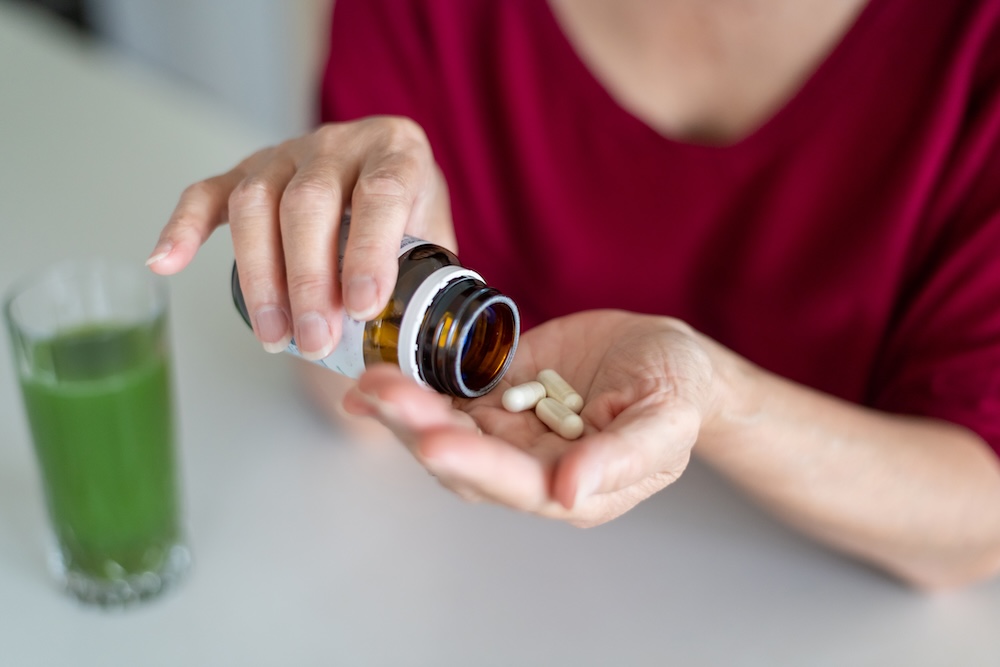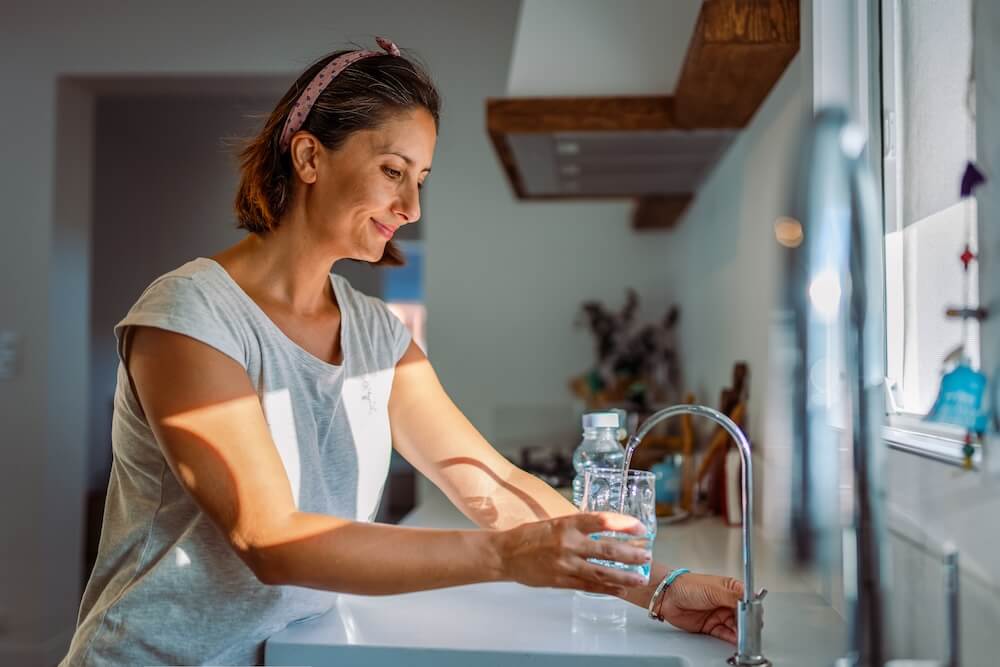It’s not just your mood, sleep and thermoregulatory system that are affected by hormones during perimenopause and menopause. Hormonal changes at this time of life can have a big impact on your skin, too. In particular, it’s the drop in oestrogen – which begins during perimenopause – that affects how your skin looks and feels.
Common menopause skin changes
Why is menopause skincare important?
Skin changes affect the majority of people during menopause and perimenopause – dry skin, wrinkles and sagging are among the most common complaints. Most importantly, these changes can affect the way you see yourself and have been found to impact quality of life.
Hormone Replacement Therapy (HRT) can help by restoring the oestrogen supply, which in turn can improve skin firmness and skin hydration levels. Of course not everyone wants to use HRT and it’s a no-go for anyone who has had oestrogen-related cancer or is at high risk. Help is at hand in the form of skincare –you just need to work out te cause of your issues and know what ingredients to look out for.
Dr Sophie Shotter, medical director and founder of Illuminate Skin Clinic in Kent, treats many women in their 40s, 50s and beyond. Here she gives us her symptom checklist and Harley Street Dermatologist Dr Emma Wedgeworth offers advice as to exactly which ingredients to look for if you feel the time is right to up the ante on your skincare.
1. Drier skin
Dr Sophie explains, “This is usually the first thing people begin to notice. During menopause, your skin produces fewer natural oils, which are what keeps it looking dewy, plus they keep water in our skin. This is because your lipid (oil) barrier deteriorates and you suffer transepidermal water loss so your skin gets much dryer.”
What can we do?
Dr Emma suggests, “The first thing to check is to make sure you’re using a gentle, non-foaming cleanser to prevent extra drying. I always suggest a creamy cleanser. Then it’s key to choose a product that can help repair the skin barrier – look for ceramides in the ingredient list for this. Another useful ingredient is niacinamide – it’s soothing as well as reparative and can also help reduce sensitivity if that’s an issue too.”
Dr Sophie and Dr Emma both recommend a moisturising product that contains hyaluronic acid. “It’s your skin’s natural sponge to help it hang on to more water,” says Dr Sophie. “So ideally try a hyaluronic acid serum followed by a ceramide-rich moisturiser.”
What to look for in your menopause skincare products?
- Non-foaming, creamy cleanser containing ceramides and niacinamide
- Moisturizing cream containing ceramides
- Hyaluronic acid serum
2. Loss of firmness
Dr Sophie explains, “Our fibroblast cells that produce collagen need a good supply of oestrogen in order to function at optimum levels. So as our oestrogen levels drop, so does our collagen production. In the first five years of menopause, we lose 30 percent of our collagen.”
Read more about collagen and menopause.
What can we do?
Dr Emma suggests, “Retinoids, such as retinol, are the gold standard for boosting volume.”
Retinoids are a group of chemicals related to vitamin A. Some – like tretinoin and adapalene – are prescription-only. Others – like retinol – can be found in a wide range of skincare products and bought without a prescription. They help prevent skin ageing by regulating the life cycle of skin cells, restoring the skin’s natural barrier, reducing water loss and slowing collagen breakdown. However, they aren’t suitable for everyone and doctors will generally advise against using them during pregnancy and breastfeeding.
Some people may be sensitive to retinoids and could try an ingredient called bakuchiol, which has also been shown to stimulate collagen and is a good alternative if retinol doesn’t agree with you.
Dr Sophie and Dr Emma are also both impressed with the new ingredient called methyl estradiolpropanoate (MEP), which can be found in some of the newer skincare lines targeted specifically for menopausal women. It may just sound like clever marketing but MEP mimics the effects of oestrogen on the skin and appears to have genuine benefits.
What to look for your menopause skincare products?
Products containing retinol, bakuchiol and MEP.
3. Fine lines and wrinkles
Dr Sophie explains, “Many women start to notice more lines and wrinkles during menopause, which is also driven by the loss of collagen. Less collagen means our skin loses structural integrity and this can result in fine lines.”
What can we do?
Dr Emma says, “Retinoids can help with fine lines and wrinkles, but let’s also not forget the importance of wearing a daily SPF. Over time the skin’s ability to protect itself against the sun will result in more wrinkles.”
“I tell my patients to wear at least an SPF 30 every day, all year round. And there’s evidence that we do not apply nearly enough of the amount of product needed. A rough guide is half a teaspoon just for the face and neck.”
What to look for your menopause skincare products?
Products with SPF 30.
4. Menopausal breakouts
Dr Sophie explains, “Many women who have had great skin throughout their adult life can find they suffer from breakouts once they hit menopause. This is because oestrogen drops much quicker than testosterone, so you can be left with unbalanced oestrogen and progesterone levels resulting in both unwanted hair and spots.”
What can we do?
Dr Emma suggests, “Look for products containing azelaic acid. On the whole, I prefer creams. From my experience, these are tolerated well during menopause. Salicylic acid can be used for breakouts, but it can be irritating and I find it more useful for treating teen acne.”
What to look for in your menopause skincare products?
Creams with azelaic acid. Speak to your doctor for further suggestions if this doesn’t help.
5. Dull-looking skin
Dr Sophie explains, “During perimenopause and menopause the turnover of your skin slows down. New skin cells come through much slower and this can result in less radiant skin than previously.”
What can we do?
Dr Emma suggests, “Superficial exfoliators such as AHAs (alpha hydroxy acids) are more effective than physical scrubs. But it’s important not to overdo the AHA as this can lead to further skin sensitivity. Less is definitely more for regaining your natural glow.”
Dr Sophie also warns, “If you do prefer a physical scrub, make sure you choose one with round beads or microdermabrasion crystals and never scrub more than twice a week. If you’re prone to redness, avoid physical scrubs altogether.”
What to look for in your menopause skincare products?
Exfoliators containing AHAs.
Final word
Shopping for skincare should now be far easier – we hope you find what works for you.
Find out more about menopause on our blog or read about skin changes in our menopause symptoms library.





